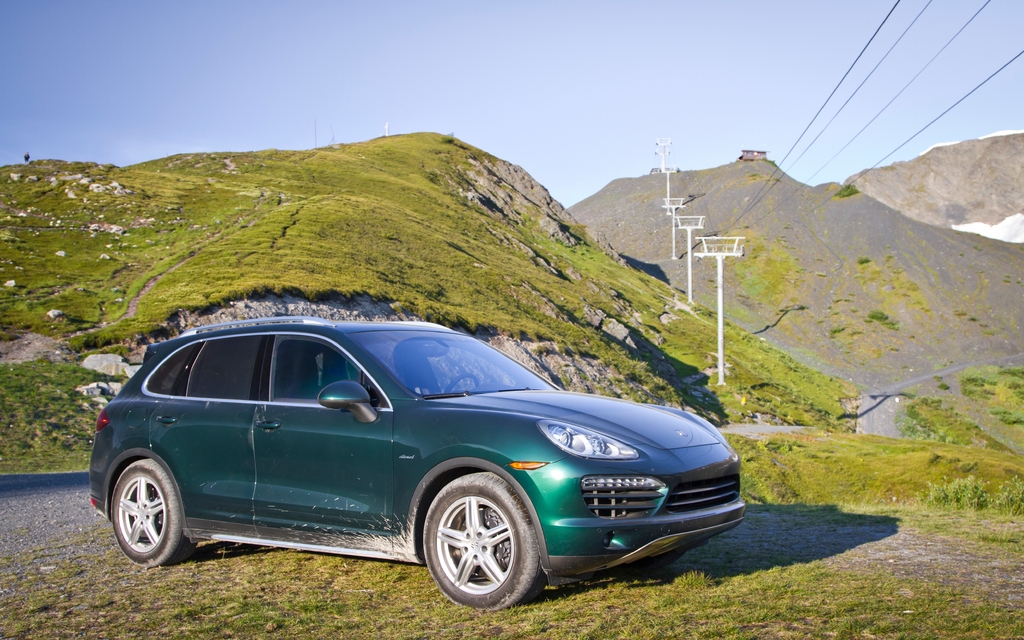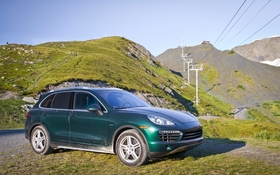2013 Porsche Cayenne Diesel: Make way for the Diesel

| Strong points |
|
|---|---|
| Weak points |
|
For the 2013 model-year, Porsche is making like the other German brands and offering a Cayenne with a diesel engine. This new version of the SUV from Stuttgart is currently rolling into dealerships, and with a base price of $64,600, it settles in between the Cayenne V6 and the Cayenne S with a V8 engine.
Why a diesel engine and why now? As buyers of diesel-powered SUVs know, this type of engine is perfect for this kind of vehicle because of its increased torque and more than reasonable fuel consumption on the highway. Moreover, the notions of performance and energy efficiency, once diametrically opposed, are increasingly teaming up, as evidenced by the recent arrival on the European market of BMW Ms with diesel engines. That’s why Porsche has decided to offer the North American market the Cayenne Diesel, which has been available in Europe since 2009.
- Also: Porsche Cayenne Cabriolet: The Crazy Idea From Newport Convertible
- Also: 2013 Porsche Cayenne: Something For Everyone
To bring this latest variation of the Cayenne to life, the engineers at Porsche went to Volkswagen/Audi and helped themselves to the 3.0-litre V6 TDI found under the hood of the Touareg and Q7. The torque remains unchanged at 406 lbs-ft, but the power has gone from 225 to 240 horses thanks to a variable geometry turbocharger and revised fuel injectors. As the Cayenne Diesel is lighter and more agile than the Touareg and Q7, it’s also faster than the Cayenne V6, going from 0-100 km/hr with a time of 7.6 seconds. However, it consumes just 6.7 litres per 100 kilometres on the highway and 10.8 in town according to Transport Canada. During our test drive, we recorded an average fuel consumption of 9.6 litres per 100 kilometres. Unfortunately, the Cayenne Diesel is not equipped with a Start/Stop system to help it be even more fuel efficient. Driving the Cayenne Diesel, all you have to do is use the maximum torque delivered between 1,750 and 2,500 rpm and let the eight-speed automatic gearbox do its thing.
You can also select manual mode by moving the stick to the side and shifting using the paddles mounted on the steering wheel. There is, however, one major flaw with the PDK gearbox: the paddle shifters. To upshift, you hit the front of one of the paddles with your thumb, and to downshift you hit the back of one of the paddles with your index finger. It’s not exactly the most natural movement, and it’s easy to inadvertently upshift while turning the steering wheel in a tight corner. The previous generation Porsche 911 Carrera used to have this same functionality, but it was replaced on the new version by a more conventional paddle shifters (the one on the left to upshift and the one on the right to downshift). It would be nice if the Cayenne adopted this same design.
It’s strange that, at only 3,500 kilos (7,716 pounds), the Cayenne Diesel’s towing capacity is the same as that of the V6 and V8 gas versions (diesel engines generally allow you to tow more than you could with a gasoline engine). What’s more, the Cayenne Diesel’s transmission doesn’t offer a low gear, which limits its off-road capabilities. Having said that, I’ve never seen a luxury SUV owner venture out on rugged terrain! Most of them consider the gravel driveway leading to the cottage as off-roading. Naturally, this would not pose a problem for the Cayenne Diesel.
Porsche vehicles are known for their dynamic ride and the Cayenne Diesel is no exception with handling that is every bit as impressive as that of the gas-powered version. It has precise steering, high-performance brakes and attacks turns with remarkable balance, which is surprising considering it weighs more than two metric tonnes. The Cayenne features best-in-class handling regardless of the engine that powers it. The only small problem is that comfort can be undermined on bad roads when the vehicle is fitted with the optional 21-inch alloy rims. That brings us to the options list, which is always long with Porsche, as evidenced by the more than $90,000 price tag on our test model. As for style, the Cayenne Diesel is identical to the other versions in the line-up, save for the “Diesel” emblem behind the front wheel well.
The addition of the diesel version helps Porsche broaden its line-up and offer an attractive alternative for the informed buyer that’s looking to improve fuel economy on the highway without sacrificing a fun ride.






